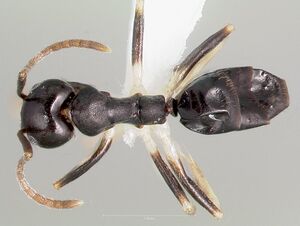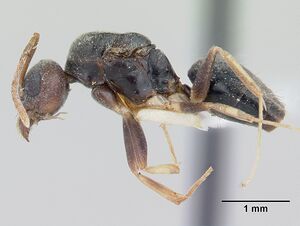Technomyrmex andrei
| Technomyrmex andrei | |
|---|---|

| |
| Scientific classification | |
| Kingdom: | Animalia |
| Phylum: | Arthropoda |
| Class: | Insecta |
| Order: | Hymenoptera |
| Family: | Formicidae |
| Subfamily: | Dolichoderinae |
| Genus: | Technomyrmex |
| Species: | T. andrei |
| Binomial name | |
| Technomyrmex andrei Emery, 1899 | |
| Synonyms | |
| |
The largest, most obvious and most widely distributed leaf litter species of Technomyrmex throughout the wet forest zones of the Afrotropical region. It is locally abundant in litter samples throughout west and central Africa and is one of the most commonly collected species of the genus in this region. It nests in and under rotten wood on the forest floor and forages widely in the leaf litter layer but is not known to ascend trees. (Bolton 2007)
Identification
Bolton (2007) - A member of the Technomyrmex bicolor group. The strikingly coloured legs, combined with its setal distribution, emarginate c1ypeus, posteriorly located eyes and size make andrei one of the most easily recognized African Technomyrmex species. Its worke.rs show considerable variation in size and weak allometric variation is present: as HW Increases then CI Increases but SI decreases.
The closest relatives of andrei are Technomyrmex parandrei and Technomyrmex metandrei. Both are certainly much rarer and much more limited in distribution. Both species share the general appearance of andrei but are distinctly differently coloured, as discussed under their respective headings.
Keys including this Species
Distribution
Latitudinal Distribution Pattern
Latitudinal Range: 9.066667° to -3.125556°.
| North Temperate |
North Subtropical |
Tropical | South Subtropical |
South Temperate |
- Source: AntMaps
Distribution based on Regional Taxon Lists
Afrotropical Region: Angola, Cameroun, Central African Republic, Democratic Republic of Congo, Gabon (type locality), Ghana, Guinea, Ivory Coast, Kenya, Liberia, Nigeria, Uganda.
Distribution based on AntMaps
Distribution based on AntWeb specimens
Check data from AntWeb
Countries Occupied
| Number of countries occupied by this species based on AntWiki Regional Taxon Lists. In general, fewer countries occupied indicates a narrower range, while more countries indicates a more widespread species. |

|
Estimated Abundance
| Relative abundance based on number of AntMaps records per species (this species within the purple bar). Fewer records (to the left) indicates a less abundant/encountered species while more records (to the right) indicates more abundant/encountered species. |

|
Biology
Castes
Worker
Images from AntWeb
   
| |
| Worker. Specimen code casent0178280. Photographer April Nobile, uploaded by California Academy of Sciences. | Owned by LACM, Los Angeles, CA, USA. |
   
| |
| Worker. Specimen code casent0424015. Photographer April Nobile, uploaded by California Academy of Sciences. | Owned by CAS, San Francisco, CA, USA. |
Queen
Images from AntWeb
   
| |
| Queen (alate/dealate). Specimen code casent0178274. Photographer April Nobile, uploaded by California Academy of Sciences. | Owned by LACM, Los Angeles, CA, USA. |
Nomenclature
The following information is derived from Barry Bolton's Online Catalogue of the Ants of the World.
- andrei. Technomyrmex andrei Emery, 1899e: 488, fig. (w.) GABON. Bernard, 1953b: 255 (q.). Senior synonym of allecta, schereri, wolfi, zumpti: Bolton, 2007a: 19.
- schereri. Technomyrmex andrei var. schereri Forel, 1911e: 283 (w.) LIBERIA. Junior synonym of andrei: Bolton, 2007a: 19.
- allecta. Engramma allecta Stitz, 1916: 394, fig. 9 (w.) DEMOCRATIC REPUBLIC OF CONGO. Combination in Technomyrmex: Shattuck, 1992c: 160. Junior synonym of andrei: Bolton, 2007a: 19.
- wolfi. Engramma wolfi Forel, 1916: 432, fig. 1 (w.) DEMOCRATIC REPUBLIC OF CONGO. Wheeler, W.M. 1922a: 204 (q.m.). Combination in Technomyrmex: Shattuck, 1992c: 161. Junior synonym of andrei: Bolton, 2007a: 19.
- zumpti. Technomyrmex zumpti Santschi, 1937b: 102 (m.) CAMEROUN. Junior synonym of andrei: Bolton, 2007a: 19.
Unless otherwise noted the text for the remainder of this section is reported from the publication that includes the original description.
Description
Worker
Bolton (2007) - TL 2.7 - 4.3, HL 0.72 - 1.06, HW 0.61 - 0.98, SL 0.78 - l.08, PW 0.44 - 0.66, WL 1.04 - 1.50 (35 measured). Indices: CI 82 - 95, SI 102 - 130, OI 25 - 30, EPI 85 - 100, DTI 144-156.
Dorsum of head behind clypeus entirely lacks setae. With head in full-face view the eyes located relatively posteriorly (EPI at least 85 and usually more) and their outer margins fail to break the outline of the sides. Anterior clypeal margin with a conspicuous broad median excavation or notch; inner margin of notch meets the more lateral portions of the anterior c1ypeal margin through rounded curves, not marked angles. Posterior margin of head with a marked median impression or emargination. Dorsum of mesosoma and declivity of propodeum entirely lack setae. First gastral tergite without setae but long stiff setae are present on gastral tergites 2 - 4, the longest of them longer than the maximum diameter of the eye. Dotsal surfaces of pronotum, mesonotum and propodeum finely and densely reticulate-punctate, usually quite sharply so but sculpture less strongly incised in some samples. Head, mesosoma, petiole and gaster more or less uniformly dark brown to black. Front legs with coxa the same colour as the mesosoma or nearly so; femur, tibia and tarsus the same or lighter, but the trochanter strikingly paler, white to yellow. Middle and hind legs with coxae, trochanters and basal one-quarter to one-third of femora white to yellow; remainder of femora darker except for apices; tibiae same colour as darker part of femora to uniformly paler than femora; tarsi yellow.
Type Material
Bolton (2007) - Holotype worker, Gabon: Ogoue (E. Andre) (Museo Civico di Storia Naturale, Genoa) [examined].
References
- Bernard, F. 1953b [1952]. La réserve naturelle intégrale du Mt Nimba. XI. Hyménoptères Formicidae. Mém. Inst. Fr. Afr. Noire 19: 165-270 (page 255, queen described)
- Bolton, B. 2007b. Taxonomy of the dolichoderine ant genus Technomyrmex Mayr (Hymenoptera: Formicidae) based on the worker caste. Contributions of the American Entomological Institute. 35(1): 1-149.
- Cantone S. 2018. Winged Ants, The queen. Dichotomous key to genera of winged female ants in the World. The Wings of Ants: morphological and systematic relationships (self-published).
- Emery, C. 1899d. Fourmis d'Afrique. Ann. Soc. Entomol. Belg. 43: 459-504 (page 488, fig. worker described)
References based on Global Ant Biodiversity Informatics
- Bernard F. 1953. La réserve naturelle intégrale du Mt Nimba. XI. Hyménoptères Formicidae. Mémoires de l'Institut Français d'Afrique Noire 19: 165-270.
- Bolton B. 2007. Taxonomy of the dolichoderine ant genus Technomyrmex Mayr (Hymenoptera: Formicidae) based on the worker caste. Contributions of the American Entomological Institute 35(1): 1-150.
- Bolton, B. "Taxonomy of the dolichoderine ant genus Technomyrmex Mayr (Hymenoptera: Formicidae) based on the worker caste." Contributions of the American Entomological Institute 35, no. 1 (2007): 1-149.
- Braet Y., and B. Taylor. 2008. Mission entomologique au Parc National de Pongara (Gabon). Bilan des Formicidae (Hymenoptera) recoltes. Bulletin S. R. B. E./K.B.V.E. 144: 157-169.
- Emery C. 1899. Fourmis d'Afrique. Annales de la Société Entomologique de Belgique 43: 459-504.
- Emery C. 1913. Hymenoptera. Fam. Formicidae. Subfam. Dolichoderinae. Genera Insectorum 137: 1-50.
- Hita Garcia F., E. Wiesel, G. Fischer. 2013. The ants of Kenya (Hymenoptera: Formicidae)faunal overview, first species checklist, bibliography, accounts for all genera, and discussion on taxonomy and zoogeography. Journal of East African Natural History 101: 127-222.
- Kone M., S. Konate, K. Yeo, P. K. Kouassi, and K. E. Linsenmair. 2012. Changes in ant communities along an age gradient of cocoa cultivation in the Oumé region, central Côte dIvoire. Entomological Science 15: 324339.
- Levieux J., and T. Diomande. 1985. Evolution des peuplements de fourmis terricoles selon l'age de la végétation dans une foret de Cote d'Ivoire intacte ou soumise à l'action humaine. Insectes Sociaux 32(2): 128-139.
- Ross S. R. P. J., F. Hita Garcia, G. Fischer, and M. K. Peters. 2018. Selective logging intensity in an East African rain forest predicts reductions in ant diversity. Biotropica 1-11.
- Shattuck S. O. 1994. Taxonomic catalog of the ant subfamilies Aneuretinae and Dolichoderinae (Hymenoptera: Formicidae). University of California Publications in Entomology 112: i-xix, 1-241.
- Wheeler W. M. 1922. Ants of the American Museum Congo expedition. A contribution to the myrmecology of Africa. II. The ants collected by the American Museum Congo Expedition. Bulletin of the American Museum of Natural History 45: 39-269.
- Yeo K., S. Konate, S. Tiho, and S. K. Camara. 2011. Impacts of land use types on ant communities in a tropical forest margin (Oumé - Cote d'Ivoire). African Journal of Agricultural Research 6(2): 260-274.
- Yeo K., T. Delsinne, S. Komate, L. L. Alonso, D. Aidara, and C. Peeters. 2016. Diversity and distribution of ant assemblages above and below ground in a West African forest–savannah mosaic (Lamto, Cote d’Ivoire). Insectes Sociaux DOI 10.1007/s00040-016-0527-6

